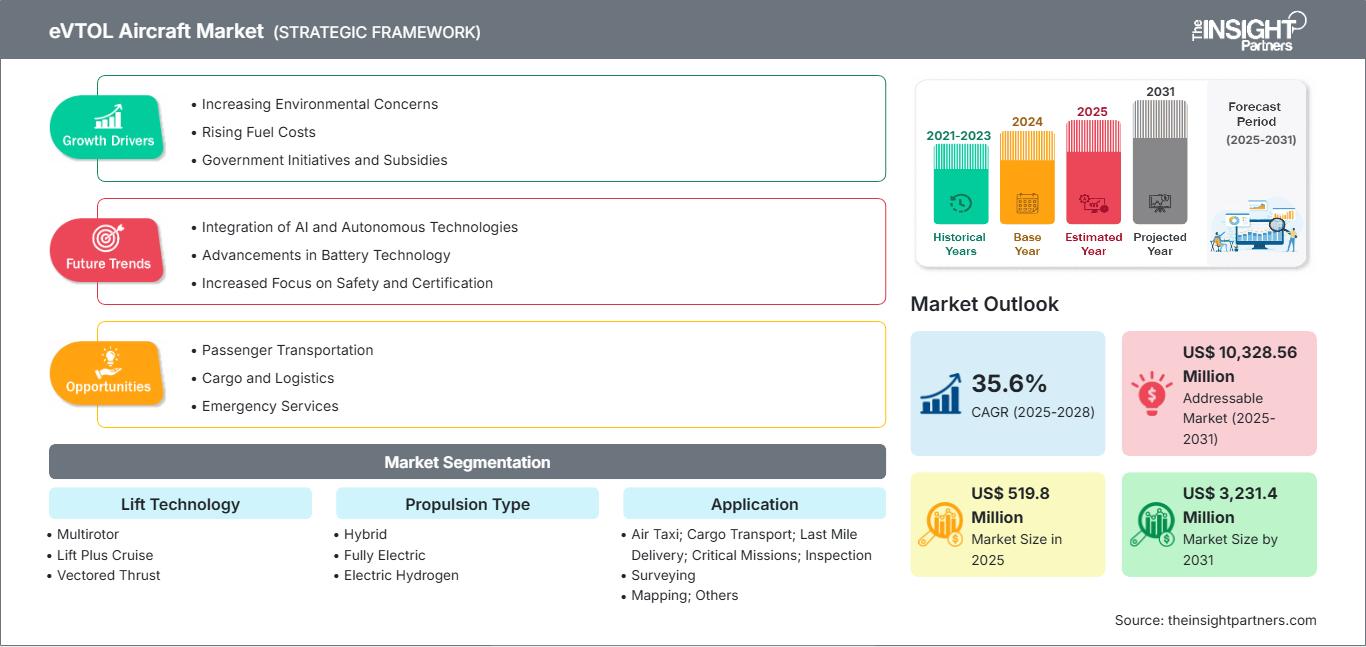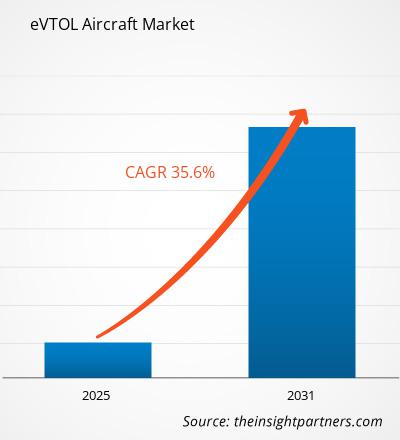Si prevede che il mercato degli aeromobili eVTOL crescerà da 519,8 milioni di dollari nel 2025 a 3.231,4 milioni di dollari entro il 2031; si prevede una crescita a un CAGR del 35,6% dal 2025 al 2031.
In base alla regione, il mercato globale degli aeromobili eVTOL è segmentato in Nord America, Europa, Asia-Pacifico e Resto del mondo. Nel 2024, si prevede che l'Europa guiderà il mercato con una quota di mercato sostanziale, seguita dal Nord America. Inoltre, si prevede che il Nord America registrerà il CAGR più elevato del mercato dal 2025 al 2031.
Il mercato degli aeromobili eVTOL è in fase di sviluppo nei paesi europei; tuttavia, le aziende leader stanno lavorando strategicamente per sfruttare le dinamiche del mercato. Ad esempio, Volocopter GmbH, produttore aeronautico tedesco e pioniere leader nella mobilità aerea urbana (UAM), aveva pianificato di lanciare la prima suite di servizi eVTOL al mondo con l'ausilio di taxi aerei per passeggeri e droni cargo per carichi pesanti tra il 2024 e il 2026. Inoltre, a marzo 2022, Jetex e Volocopter hanno firmato un accordo di partnership strategica per definire un modello di mobilità aerea urbana sicuro e sostenibile. La partnership è stata istituita per implementare e gestire infrastrutture e servizi di decollo e atterraggio UAM taxi permanenti, economicamente sostenibili e integrati per il trasporto passeggeri.
Secondo l'analisi di mercato, si prevede che il Nord America sarà la regione in più rapida crescita nel mercato globale dei velivoli eVTOL durante il periodo di previsione. Ciò è dovuto alla presenza di numerose aziende eVTOL nella regione, tra cui fornitori come Archer Aviation, Alakai Skai, Opener Aero, BETA Technologies, Gravitas, Joby Aviation, Wisk Aero LLC., Jaunt Air Mobility, Kittyhawk e Bell Textron Inc. Il mercato degli aeromobili eVTOL è in fase di sviluppo e si prevede che crescerà nei prossimi anni in Nord America, grazie al crescente numero di investimenti e iniziative strategiche da parte di attori chiave del settore. Ad esempio, a febbraio 2021, United Airlines e Archer Aviation hanno annunciato una partnership per sfruttare l'esperienza aeronautica della compagnia aerea internazionale. In base alla partnership, United Airlines avrebbe acquistato 200 aeromobili eVTOL da Archer. Inoltre, a giugno 2021, Vertical Aerospace ha annunciato accordi per un valore di 4 miliardi di dollari con American Airlines, Virgin Atlantic e il gruppo di leasing Avolon per un massimo di 1.000 dei suoi aeromobili eVTOL VA-X4.
Personalizza questo rapporto in base alle tue esigenze
Potrai personalizzare gratuitamente qualsiasi rapporto, comprese parti di questo rapporto, o analisi a livello di paese, pacchetto dati Excel, oltre a usufruire di grandi offerte e sconti per start-up e università
Mercato degli aeromobili eVTOL: Approfondimenti strategici

- Ottieni le principali tendenze chiave del mercato di questo rapporto.Questo campione GRATUITO includerà l'analisi dei dati, che vanno dalle tendenze di mercato alle stime e alle previsioni.
Potrai personalizzare gratuitamente qualsiasi rapporto, comprese parti di questo rapporto, o analisi a livello di paese, pacchetto dati Excel, oltre a usufruire di grandi offerte e sconti per start-up e università
Mercato degli aeromobili eVTOL: Approfondimenti strategici

- Ottieni le principali tendenze chiave del mercato di questo rapporto.Questo campione GRATUITO includerà l'analisi dei dati, che vanno dalle tendenze di mercato alle stime e alle previsioni.
Impatto della pandemia di COVID-19 sul mercato degli aeromobili eVTOL
L'impatto complessivo della pandemia di COVID-19 sul settore dell'aviazione è grave. Si prevede che l'industria aeronautica globale perderà circa 200 miliardi di dollari dal 2020 al 2022. L'impatto della pandemia ha portato a un calo della produzione di aeromobili, all'interruzione della catena di approvvigionamento durante l'anno fiscale 2020, al rinvio di nuovi ordini, a difficoltà di trasporto per l'approvvigionamento di materiali o componenti e a difficoltà di manodopera per i fornitori del settore aeronautico. Ciò ha avuto un impatto negativo anche sul settore eVTOL. Poiché il settore eVTOL è ancora in fase di sviluppo e necessita di una crescita economica crescente per sostenere gli sviluppi del settore eVTOL, i progetti in corso come test, certificazione e produzione di prototipi hanno subito un forte impatto durante la pandemia.
Approfondimenti di mercato - Mercato dei velivoli eVTOL
L'Europa è leader nell'adozione di velivoli eVTOL, nei progressi tecnologici e nella spesa per le tecnologie eVTOL. Questo è il principale motore della crescita del mercato dei velivoli eVTOL. Il mercato europeo dei velivoli eVTOL ha iniziato a registrare una rapida ripresa per il suo sviluppo. Aziende come Lilium e Volocopter hanno anche registrato un numero crescente di preordini, che dovrebbero aumentare le dimensioni del mercato una volta commercializzati. Ad esempio, nel 2021, Lilium ha annunciato di essersi già aggiudicata un contratto del valore di 1 miliardo di dollari, in base al quale l'azienda si accinge a fornire 220 unità dei suoi velivoli eVTOL a 5 posti a Luxaviation Group. Inoltre, nel 2022, Lilium ha ricevuto un altro preordine di 150 jet a sei passeggeri che NetJets fornirà nei prossimi anni. Il lockdown ha ulteriormente interrotto la produzione e i test del velivolo eVTOL e dei suoi prototipi dal 2020 al 2021. Tuttavia, contrariamente ai fattori sopra menzionati, gli operatori del mercato europeo dei velivoli eVTOL sono riusciti ad acquisire contratti relativi allo sviluppo di velivoli eVTOL da investitori e partner in tutta la regione. Ciò ha ulteriormente consentito agli operatori del mercato di generare ricavi, eseguire vari test di volo e contribuire allo sviluppo del mercato dei velivoli eVTOL.
Il mercato dei velivoli eVTOL è segmentato in base alla tecnologia di portanza, al tipo di propulsione, all'applicazione e alla modalità operativa. In base alla tecnologia di portanza, il mercato dei velivoli eVTOL è segmentato in multirotore, portanza più crociera, spinta vettoriale e altri. In base al tipo di propulsione, il mercato è segmentato in ibrido, completamente elettrico ed elettrico a idrogeno. In base all'applicazione, il mercato è suddiviso in aerotaxi; trasporto merci; consegne dell'ultimo miglio; missioni critiche; ispezione, rilevamento e mappatura; e altri. In base alla modalità operativa, il mercato degli aeromobili eVTOL è segmentato in pilotati, pilotati facoltativamente e autonomi.
Airbus (Paesi Bassi), Bell Textron Inc. (Stati Uniti), Boeing (Stati Uniti), Eve Air Mobility (Brasile), Lilium GmbH (Germania), Opener (Stati Uniti), EHang (Cina), BETA Technologies (Stati Uniti), Pipistrel Group (Slovenia), Volocopter GmbH (Germania), Joby Aviation Inc. (Stati Uniti), Heart Aerospace (Svezia) e Archer Aviation Inc. (Stati Uniti) sono tra i protagonisti profilati durante lo studio del mercato degli aeromobili eVTOL.
Mercato degli aeromobili eVTOL
Le tendenze regionali e i fattori che influenzano il mercato degli aeromobili eVTOL durante il periodo di previsione sono stati ampiamente spiegati dagli analisti di The Insight Partners. Questa sezione analizza anche i segmenti e la geografia del mercato degli aeromobili eVTOL in Nord America, Europa, Asia-Pacifico, Medio Oriente e Africa, America Meridionale e Centrale.
Ambito del rapporto sul mercato degli aeromobili eVTOL
| Attributo del rapporto | Dettagli |
|---|---|
| Dimensioni del mercato in 2025 | US$ 519.8 Million |
| Dimensioni del mercato per 2031 | US$ 3,231.4 Million |
| CAGR globale (2025 - 2028) | 35.6% |
| Dati storici | 2021-2023 |
| Periodo di previsione | 2025-2031 |
| Segmenti coperti |
By Tecnologia di sollevamento
|
| Regioni e paesi coperti | Nord America
|
| Leader di mercato e profili aziendali chiave |
|
Densità degli operatori del mercato degli aeromobili eVTOL: comprendere il suo impatto sulle dinamiche aziendali
Il mercato dei velivoli eVTOL è in rapida crescita, trainato dalla crescente domanda degli utenti finali, dovuta a fattori quali l'evoluzione delle preferenze dei consumatori, i progressi tecnologici e una maggiore consapevolezza dei vantaggi del prodotto. Con l'aumento della domanda, le aziende stanno ampliando la propria offerta, innovando per soddisfare le esigenze dei consumatori e capitalizzando sulle tendenze emergenti, alimentando ulteriormente la crescita del mercato.

- Ottieni il Mercato degli aeromobili eVTOL Panoramica dei principali attori chiave
Gli operatori del mercato dei velivoli eVTOL si concentrano principalmente sullo sviluppo di prodotti avanzati ed efficienti, fusioni e partnership.
- Nel 2022, Thales ha stretto una partnership con Eve per lo sviluppo dell'eVTOL. Thales ha annunciato il suo supporto allo sviluppo del suo velivolo eVTOL in Brasile. La partnership strategica prevede una serie di studi congiunti, della durata di dodici mesi e iniziati a gennaio 2022, sulla fattibilità tecnica, economica e adattabile di un velivolo alimentato al 100% elettricamente.
- Nel 2021, Heart Aerospace ha stretto una partnership con Arennova Aerospace SA per la progettazione congiunta della struttura del nuovo velivolo elettrico ES-19, un velivolo completamente elettrico progettato per trasportare diciannove passeggeri su brevi rotte regionali. Arennova Aerospace SA collaborerà con gli ingegneri di Heart nella progettazione dell'ala, della fusoliera e dell'impennaggio.
- Analisi storica (2 anni), anno base, previsione (7 anni) con CAGR
- Analisi PEST e SWOT
- Valore/volume delle dimensioni del mercato - Globale, Regionale, Nazionale
- Industria e panorama competitivo
- Set di dati Excel
Report recenti
Testimonianze
Motivo dell'acquisto
- Processo decisionale informato
- Comprensione delle dinamiche di mercato
- Analisi competitiva
- Analisi dei clienti
- Previsioni di mercato
- Mitigazione del rischio
- Pianificazione strategica
- Giustificazione degli investimenti
- Identificazione dei mercati emergenti
- Miglioramento delle strategie di marketing
- Aumento dell'efficienza operativa
- Allineamento alle tendenze normative






















 Ottieni un campione gratuito per - Mercato degli aeromobili eVTOL
Ottieni un campione gratuito per - Mercato degli aeromobili eVTOL